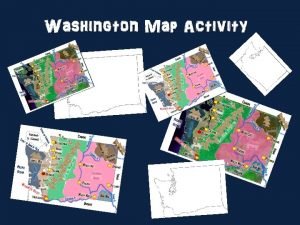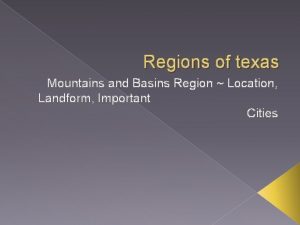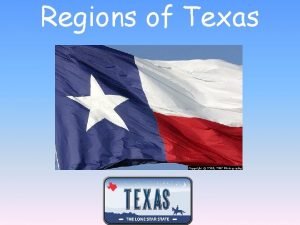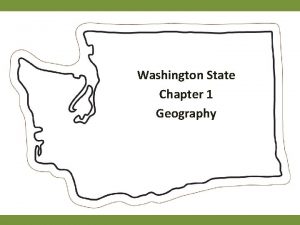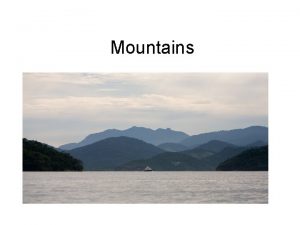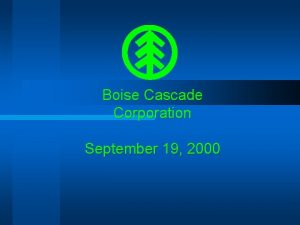Animals of Washington State Cascade Mountains and Okanogan



















- Slides: 19

Animals of Washington State (Cascade Mountains and Okanogan Highlands ). By: Claire R, Sophia M, and Zack H, Max R, Katherine J, and Katherine K.

Trumpeter Swan Scientific name: Cygnus buccinator Higher Clasification: Swan These swans are impressively large, adult swans will grow about 138 -165 cm in length and are one of the heaviest living birds that are able to take flight. In the 1960’s the federal endangered species act came into being, the Trumpeter Swan was considered for this list.

American White Pelican Scientific Name: Pelecanus erythrorhynchos Length: 127 -165 cm Wingspan: 244 -290 cm. Pelicans are skillful food thieves. The American White Pelicans are quite common.

Osprey Scientific name: Pandion haliaetus Length: 50 -66 cm Wingspan: 60 cm One of the most widespread birds of prey (can be found on every continent except Antarctica) Also called fish eagle, sea hawk, river hawk, and fish hawk

Saw-Whet Owl They have small bodies with a large heads They have large wings They are nocturnal They are predators Their scientific name; Aegolius acadicus They are about 5’’ tall They eat mice and small rodents They produce multiple eggs at a time.

River otters The species present around us is the North American otter The scientific name is lontra canadiense River otters habitat need a permanent food supply and access to water. They like coastal and marine habitats including rivers and lakes. They reproduce only during mating season.

Marten The species around us is the American marten. The scientific name for the marten is martes. Their habitat is a number of mature mixed or coniferous forests in the Pacific Northwest. How they reproduce- One male may mate with many females during a year. When females are ready to breed, they alert males by making scent markings in their territories. Before mating, a pair will wrestle and play together. They bear 3 children at a time.

Grizzly Bear! The grizzly bear, is native to North America It is a brown furry bear weighing at 180 -360 kg. The average height is 200 cm. This fearsome animal is very popular in Native American myths and legends.

Mountain Goat The mountain goat, native to North America, is a climber found on cliffs and ice. Mountain goats are herbivores meaning they eat plants like grass, moss, and ferns. Mountain goats live in the Rocky Mountains and the Cascades. They are the largest mammal found in their altitude the altitude can be of 4 km

Bobcat Name of species: Bobcat Scientific name; Lynx rufus Bobcats can exist in many Different climates and habitats The litter size can be 1 -6 kittens They are pregnant for 50 -70 days They can live in forest`s, deserts, and brush land They hunt rabbits and hares Also eat birds and baby farm animals

Coyote Their scientific name is Canis latrans They live in dens that they usually they dig from other roots of a tree Breeding is in the late winter They can have between 1 and 19 pups but the average is 6 pups The coyotes are pregnant for 60 -63 days Coyotes can live up to 10 years in the wild and even longer(up to 18 yrs. ) in captivity Coyotes mostly live in forests

Pygmy Shrew ● ● ● ● ● Scientific name: Sorex Hoyi Due to its fast metabolism, it needs to eat constantly Believed to be the second smallest mammal in the world Has a extremely large appetite for its size About 5 cm in length including a 2 cm long tail. Weighs about 2 - 4. 5 g Pygmy shrews are distributed throughout the boreal areas of North America. Although S. hoyi prefers moist habitats, it has been recorded to live in areas with both wet and dry soil Females produce a litter of 3 -8 young, and only give birth once a year from November through March. They are independent by 25 days old.

Ermine ● ● Scientific name: Mustela erminea Though the name Ermine is used often, Stoat is the official name. Habitat and Ecology: The Stoat occupies a wide range of habitats. It is often found in successional or forest-edge habitats, in scrub, alpine meadows, marshes, riparian woodlands, hedgerows, and riverbanks that have high densities of small mammals. The female bears her annual litter of 4 -18 (average 6) in April or May. Their eyes open at 28 -48 days, the females first.

Badger The species near us is the American Badger The scientific name is Taxidea Taxus They like to live in dry, open grasslands, fields, and pastures they can be found high up and lower closer to sea level They have about 3 kids at a time

Resident cutthroat Other names: Sea-Run Cutthroat, Harvest Trout Average size: . 5 -1. 8 kilograms, and up to 2. 7 kilograms and are 1. 5 meters long

Sources: http: //okanoganhighland. blogspot. com/p/wildlife-of-okanogan-highlands. html http: //www. conservationnw. org/what-we-do/columbiahighlands/wildlife http: //www. defenders. org/bobcats http: //naturemappingfoundation. org/natmap/facts/coyote_712. html http: //wdfw. wa. gov/living/bobcats. html http: //www. thepetitionsite. com/takeaction/698/443/706/ http: //pugetsoundbirds. org http: //wdfw. wa. gov/fishing/salmon/cutthroat. html

Sources: https: //en. m. wikipedia. org/wiki/American_pygmy_shrew https: //en. m. wikipedia. org/wiki/Stoat# https: //en. m. wikipedia. org/wiki/Northern_pygmy_owl https: //en. m. wikipedia. org/wiki/American_marten http: //kids. nationalgeographic. com/animals/river-otter/#river-otter-swimming. jpg https: //m. youtube. com/watch? v=6 b. FD 0 rc 9 b-Y http: //wyominguntrapped. org/tag/american-marten/ https: //www. giantbomb. com/badger/3015 -4629/ http: //www. animalsandenglish. com/badgers. html http: //animalsadda. com/badger/ http: //www. flyfishinginsidernewsletter. com/021906/

https: //weather. com/photos/news/mountain-goats-how-do-they-do-itl http: //www. sfzoo. org/explore/animals/mammals-2/grizzlybear. htm http: //www. audubon. org/field-guide/bird/american-white-pelican http: //www. audubon. org/field-guide/bird/osprey http: //animalstime. com/trumpeter-swan-facts/

THANKS FOR WATCHING!
 Cascade mountains labeled on map
Cascade mountains labeled on map Cascade mountains wildlife
Cascade mountains wildlife Texas mountains and basins
Texas mountains and basins Texas north central plains animals
Texas north central plains animals Is a horse a producer consumer or decomposer
Is a horse a producer consumer or decomposer Parasitic food chain example
Parasitic food chain example Carnivore
Carnivore Washington state department of social and health services
Washington state department of social and health services Washington state board of technical and community colleges
Washington state board of technical and community colleges Https://a-z-animals.com/animals/
Https://a-z-animals.com/animals/ Washington eap
Washington eap Washington state geography
Washington state geography Shiba rainbow chart
Shiba rainbow chart Crna washington state
Crna washington state Biomes in washington
Biomes in washington Washington state apprenticeship programs
Washington state apprenticeship programs Washington state dairy council
Washington state dairy council Wheres washington state
Wheres washington state Washington state radon map
Washington state radon map Social emotional learning standards washington state
Social emotional learning standards washington state
